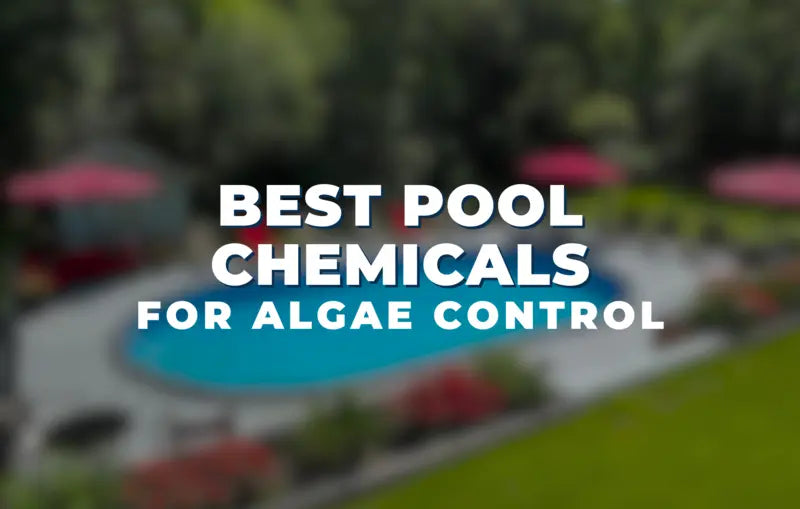Best Pool Chemicals
for Algae Control
Algae Control made easy! Discover the best pool chemicals to prevent and eliminate algae. Learn tips for maintaining clean, balanced water all season long.

Maintaining a clean and inviting pool is a top priority for every pool owner. Algae growth, however, can quickly turn your sparkling oasis into a murky mess. The right chemicals make all the difference in keeping algae at bay. This guide explores the best pool chemicals for effective algae control, helping you enjoy a crystal-clear swimming experience.
Why Algae Growth Happens
Algae thrive in warm, stagnant water, especially when chlorine levels are low. Poor filtration or insufficient cleaning allows algae to take hold. Contaminants such as leaves, dirt, and oils provide nutrients that promote algae growth. Regular maintenance and the right chemical treatments can prevent these conditions.
Chlorine: The Frontline Defense Against Algae
Chlorine is the most effective chemical for algae control. It destroys algae spores before they multiply. Maintaining a chlorine level of 1-3 parts per million (ppm) ensures optimal protection. Test your pool water regularly to avoid dips in chlorine levels. Shock treatments, which involve adding a large dose of chlorine, eliminate existing algae blooms.
Algaecides: Targeted Algae Control
Algaecides are specifically designed to kill algae. These chemicals come in two main types: copper-based and quaternary ammonium compounds. Copper-based algaecides work well for green and mustard algae. Quaternary ammonium algaecides, often called "quats," prevent algae from forming on pool surfaces. Use algaecides as a preventive measure or alongside shock treatments for maximum effectiveness.
Eclipse 3 Granular Algaecide is a powerful option for controlling algae. Its fast-acting formula effectively eliminates stubborn green and mustard algae. The granular form allows for easy application, ensuring even distribution across your pool. Regular use of Eclipse 3 helps prevent future algae outbreaks, keeping your water clear and safe for swimming.

Preventing Algae with Pool Stabilizers
Stabilizers, like cyanuric acid, help maintain consistent chlorine levels. Direct sunlight depletes chlorine, making your pool more vulnerable to algae. Adding a stabilizer protects chlorine from UV rays, ensuring it works efficiently. Keep stabilizer levels between 30-50 ppm for optimal results. Overusing stabilizers, however, can hinder chlorine’s effectiveness, so monitor levels carefully.
pH Balance: A Key Factor in Algae Control
Maintaining a balanced pH is essential for effective algae prevention. A pH level between 7.2 and 7.6 ensures chlorine works at full strength. High pH levels reduce chlorine’s ability to kill algae. Use pH increasers or decreasers to keep levels in check. Test your pool water weekly to address imbalances promptly.
Pool Shock: A Powerful Solution for Algae Outbreaks
When algae blooms take over, a pool shock treatment provides a quick fix. Calcium hypochlorite or Sodium Dichloro-s-triazinetrione are common pool shock options. These chemicals deliver high chlorine concentrations to kill algae. Always follow the manufacturer’s instructions for dosage and application. Shocking your pool after heavy rain or high swimmer activity prevents algae from forming.

Effective Use of Phosphate Removers
Phosphates are nutrients that algae need to grow. Removing them from your pool water starves algae and prevents blooms. Phosphate removers bind with phosphates, allowing your pool filter to remove them. Regular use of phosphate removers keeps algae from thriving. Pair this treatment with other preventive measures for the best results.
Brushing and Filtration: Chemical Support
Chemicals alone can’t keep algae at bay. Brushing pool walls and floors removes algae spores before they take hold. A clean filter supports chemical treatments by removing debris and contaminants. Backwash your filter regularly to maintain efficiency. Combine physical cleaning with chemical treatments for a truly algae-free pool.
Using a robotic pool cleaner can significantly enhance algae control by removing dirt and debris that contribute to algae growth. These automated cleaners scrub pool walls and floors, preventing algae spores from settling and multiplying. They also improve water circulation, helping chemicals distribute more evenly. Adding a robotic cleaner to your maintenance routine reduces manual labor and keeps your pool consistently clean.
Seasonal Algae Control Tips
Different seasons require specific strategies to prevent algae. In summer, high temperatures encourage algae growth. Increase chlorine levels and clean your pool more frequently. During the off-season, winterizing your pool with algaecides and covers keeps algae at bay. Tailoring your approach to the season ensures long-term success.

Choosing the Best Chemicals for Your Pool
Not all pool chemicals are created equal. Always choose high-quality products for reliable results. Read labels carefully to ensure compatibility with your pool type. Consult a pool professional if you’re unsure about the best options for your needs. Investing in the right chemicals saves time and money in the long run.
Conclusion: The Key to Algae-Free Swimming
Keeping your pool free of algae requires a proactive approach. Regular maintenance, balanced water chemistry, and high-quality chemicals are essential. Chlorine, algaecides, stabilizers, and other treatments work together to ensure effective algae control. With consistent care, you can enjoy a clean and safe pool all season long.
Eclipse 3 Granular Algaecide 2lbs.
An all-natural mineral treatment for pools, spas and hot tubs. It has been proven to perform extremely well in three main areas; it eliminates algae growth and reduces your use of chlorine, clarifies the water while maintaining a proper pH level, and can reduce your electrical operating costs by as much as 66%. Learn more...















